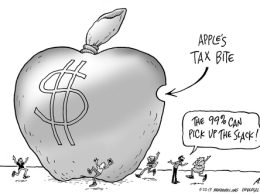In Part two of a three part article on the Irish economy, Paul Murphy looks at some of the factors depressing the domestic economy, focusing on debt and unemployment, as well as analysing whether the government’s export focused strategy can be successful.
Part one of the article “Irish recession – Is the worst over? on the prospects for the Irish economy outlined the difficult international environment and the key strategy of the Irish capitalist establishment, “internal devaluation”. In Part two, Paul Murphy looks at some of the factors depressing the domestic economy, focusing on debt and unemployment, as well as analysing whether the government’s export focused strategy can be successful
Debt crisis looms
In many ways one can now talk about Ireland moving into a second phase of the economic crisis. The first was dominated by the collapse in the housing market, the impact of the international crisis and the devastating results in terms of unemployment and assaults on wages and the public sector in particular. The second will see the continuation of a worsening of unemployment and attacks on working people, together with a growing crisis of public and, in particular, private debt.
This debt crisis has the potential to cause another wave of banking crisis in Ireland, see thousands being threatened with eviction from their homes with a resultant social and political crisis and fatally undermine consumer spending.
All of the conditions for a massive debt crisis are in place. Before the onset of this crisis, working people were already burdened with unprecedented levels of debt. In fact, as was outlined previously, this was an important basis of the bubble that developed. For example, the ratio of personal debt to disposable income is estimated to have more than tripled in the last 15 years to around 170%.
Such a level of indebtedness would be manageable on the basis of rising incomes and close to full employment. However, the opposite is now clearly the case. Rocketing unemployment and downward pressure on wages now make it increasingly difficult for many people to pay back their debts (a mortgage being the most important debt for most). While interest rates coming down over the last year has eased this process somewhat, the European Central Bank is now seeking to increase interest rates slowly but surely again, which will have a significant impact on people’s ability to pay back their mortgages. For example, an increase of 1% in interest rates will mean someone who has a mortgage of €300,000 will have to pay around an extra €200 a month – that can be the straw that breaks the camel’s back for many.
To add to this difficult situation, Ireland is also experiencing dramatically falling house prices. House prices have already fallen by over 30% since February 2007, but they are likely to continue to fall given the fact that houses remain overvalued in relation to the average ratio of income to house prices, and the economic situation. Morgan Kelly, the UCD economist, in his paper “On the likely extent of falls in Irish house prices” (published in 2007) in comparing 40 booms in house prices across OECD countries concluded that:
“Typically, real house prices give up 70 per cent of what they gained in a boom during the bust that follows. This is a remarkably robust relationship, holding across very different OECD housing markets over more than 30 years.”
This would indicate that house prices will continue to drop for a number of years and for another 30% or more. This has already, and will increasingly do so as prices fall further, create a situation of negative equity, i.e. where people’s mortgages are worth more than the value of their homes. As outlined in the first part of this article, the consciously deflationary policies of the government will also increase the burden of debt on working people and the government.
Ireland is of course not the first country to experience this poisonous cocktail of high debt, combined with rising unemployment and falling wages and house prices. The US has experienced precisely that phenomenon – and the result is now evident – a wave of foreclosures with people put out of their houses. In September 2009, 14.4% of US mortgages were at least one payment behind or in foreclosure, while in Florida, which according to Kelly in his paper on the “Irish Credit Bubble” most closely resembles Ireland, the figure is 25%.
A similar scenario is likely to develop in the Irish economy in the latter half of this year. The results may be dramatic.
What will be the consequences of a debt crisis?
The first consequence will be the potential for a second banking crisis. Stephen Kinsella on the progressive-economy.ie blog did some simple sums that give a sense of how real this prospect is:
“To get a very rough sense of the scale of the problem, multiply the 196,000 homes in negative equity [an estimate worked out by David Duffy of the ESRI – PM] by the average mortgage price of a home today, around €235,260. We have €46,110,960,000 of potential bad debts for banks, just from this pool alone. 46 billion euros. If even 15 or 20% of those homes, and only those homes, default, we have another banking crisis, because banks won’t have the capital to absorb so much bad personal debt at once.” (Will there be a NAMA for personal debt? October 21 2009)
The second impact is the enormous social and political ramifications of widespread mortgage defaults. Evictions being carried out by the same banks that have been bailed out to the tune of billions by working people would obviously be a source of enormous resentment and conflict. Huge pressure will come to bear on the government and the banks to avoid widespread evictions. There is the potential for major movements to develop around this issue.
In the more medium to long term, the experience of such a drastic debt crisis can have severely negative effects on the prospects for the Irish economy in the future. The experience of countries like Japan suggests that the impact of such a severe crisis can have lasting impacts on the willingness of the private sector to spend as a result of what Richard Koo, author of “The Holy Grail of Macro Economics: Lessons from Japan’s Great Recession” describes as “debt trauma”. Therefore a lasting legacy of the debt can be the undermining of the consumer spending that was central to economic growth.
Jobs depression will worsen and hamper recovery
To add to the depressing effect of debt, the issue of unemployment will worsen throughout the course of 2010. Even the most optimistic commentators cannot deny the reality of rising unemployment figures. The live register figures indicate that 426,700 people signed on (this includes some part-time workers and others entitled to jobseekers benefit or allowance) in December 2009. The Quarterly National Household Survey (the official figure for unemployment) gives the seasonally adjusted figure for July to September 2009 as 270,800 people unemployed. The official rate (from February 2010) of unemployment is now 12.7%.
However, the official figures significantly understate the extent of the problem, because they fail to take into account those dropping out of the labour force and those emigrating. Economist Ronan Lyons examined this phenomenon in the case of the demographic segment of the population hit hardest by unemployment, young men between 15 and 24 on his blog. He illustrates quite graphically how the extent of the collapse in employment in this sector is camouflaged.
In the middle of 2006, 175,000 of the 192,000 of those in the labour force in that demographic were employed. Now almost 100,000 jobs have been lost in this sector – in other words over 55% of jobs for young men have disappeared. These incredible figures are not fully represented in the official unemployment figures,15% of these job losses do not show up because of people dropping out of the labour market, while another 20% of the job losses are hidden by the phenomenon of emigration.
The speed of collapse of employment in the Irish economy is almost without precedent. An interesting comparison with that of the US now and in the 1930s was also done by Lyons. In percentage terms, and in the shape of the decline, the figures are stark (see graph). About 270,000 private sector jobs have been lost in Ireland – around 16% of all private sector jobs. That compares only marginally favourably to that of the US in the 1930s which at this stage in that depression had lost 18% of jobs from peak employment, and markedly unfavourably with current US figures, which are down by around 6%.
 Ronan Lyons correctly argues that this means that Ireland is suffering what he describes as “a severe jobs depression”.
Ronan Lyons correctly argues that this means that Ireland is suffering what he describes as “a severe jobs depression”.
Those who say we have turned a corner need only to examine the figures for redundancy notices. Monthly redundancy notices in January 2010 were the highest since June 2009, higher than January 2009 and 4% higher than the monthly average for the entire last year. This confirms what would anecdotally seem to be the case – that redundancies in the private sector are continuing apace. Unemployment will continue to rise, with the OECD estimating that it may approach 15% by the end of 2010.
This is not a short term problem. Even the Quarterly ESRI report which predicts small growth in 2010 admits that unemployment will continue to rise. How long will it take to get back to the levels of employment that were experienced before the crash? Using optimistic predictions, Lyons concludes that “it will be in 2018, after almost 100 months of jobs growth, until we see 2007 employment levels again – and that’s only if jobs growth returns within the next 12 months.”
Therefore the issue of unemployment will continue to be a crucial theme in the unfolding of the economic crisis in Ireland. It will obviously have devastating social effects on communities and families. As is already happening, the existence of mass unemployment will be used to depress the wages of hose in the private sector, further pushing down demand. It will function like a heavy rock on the Irish economic recovery for many years to come, depressing demand and undermining hopes for a buoyant recovery based on the domestic economy.
Can exports offer an alternative strategy?
Debt and unemployment are just two of the bleakest aspects of the domestic economic situation. Both have yet to reach their lowest point. Any talk of recovery based on domestic factors is clearly hollow. This then lies behind the government’s central strategy of “internal devaluation” to increase export competitiveness and export our way out of the crisis.
There is no question that exports have become absolutely central to the Irish economy. Over the past 50 years, there has been a dramatic shift away from self-sufficiency to an export oriented economy. The result is that exports of goods and services are now equivalent to over 80% of Ireland’s GDP compared to less than 30% in 1960.
However, can export growth be achieved to pull Ireland out of recession in the short to medium term? To answer that question it is necessary to ascertain what the nature of exports from the Irish economy is. How have they fared in the course of the world recession? What is the prospect of a significant increase in exports?
The first point it is necessary to tackle is the false idea that is consciously propagated by the government that the extent of the recession in Ireland is mainly as a result of the international crisis resulting in a dramatic drop in exports. This argument suits the establishment for two reasons – firstly because it gets the bankers and speculators who were responsible for the domestic bubble in property off the hook, secondly because it ties into the argument that what is needed is falling wages to enable Ireland to recover world export share.
This is simply not the case. It is a fact that while Ireland’s exports lagged in the post-2001 period, during the crisis itself exports from Ireland have performed remarkably well. In fact in the first half of 2009, exports from Ireland were up about two per cent on last year. The overall figures suggest that Irish exports declined by 1% in the course of 2009, but this marks an increase in share of world exports as most countries’ exports have fallen by more than that.
This quite decisively proves that it is not the case that the crisis is primarily as a result of fallen exports and that all that is necessary is to return them to previous highs. The problem is primarily domestic, but as is outlined above, that is unlikely to improve dramatically.
The question then is whether Irish exports can increase so dramatically as to overcome the weaknesses of the domestic economy and give impetus to economic growth once more? In effect, what would be needed is a repetition on a smaller scale of the beginning stages of the Celtic Tiger. In theory, this could be based either primarily on foreign direct investment (mirroring the Celtic Tiger) or on indigenous development? What are the prospects for these?
Can an export boom based on foreign direct investment re-develop?
The Socialist Party has dealt elsewhere with the phenomenon of the Celtic Tiger. (See “The Endangered Celtic Tiger” by Kevin McLoughlin). We have pointed out that it was based on the coming together of a number of favourable circumstances for a significant influx of foreign direct investment, which was primarily export-oriented. These factors were Ireland’s membership of the EU, the existence of a relatively well-educated and low cost workforce and to a lesser extent low corporation tax rates. The result was a significant influx of foreign direct investment, which went from $85.1 million in 1989 to $25.5 billion in 2000!
Can this feat now be repeated? All the evidence would point to the contrary. The likes of Intel and Dell are illustrations of the opposite process that is taking place. Rather than an increase in export-oriented Foreign Direct Investment, many of those companies that came in the Celtic Tiger period are now moving east.
Would wage cuts assist in keeping these companies and attracting others? Not unless you are talking about such drastic wage cuts to enable workers in Ireland to “compete” (in a race to the bottom of course) with lowly-paid workers in eastern Europe or China. Even if that was achieved, and it did not have the inevitable consequence of a slump in domestic demand, it still would not necessarily be successful. Only 15% of global FDI is located in low-wage economies, indicating that low wages are not the only consideration of capitalists when choosing where to invest.
The particular features in Ireland that gave rise to the Celtic Tiger are no longer present. Most of those US companies that were looking for a European base for European manufacturing already have one. For those that are looking for a base, Ireland is no longer the only, or even the most attractive option, given the accession of eastern European countries. This effectively rules out a resurgence of exports based on Foreign Direct Investment.
Can indigenous owned exports provide the stimulus to get Ireland out of recession?
Even much of the establishment analysis implicitly acknowledges that a FDI driven export boom is unlikely. Instead what lies behind much of the rhetoric about a “smart economy” or “knowledge economy” is the idea that there could be a boom in indigenous exports. What are the prospects for the indigenous sector?
 Here the picture is even bleaker in reality and underlines the fact that the historic weakness of Irish capitalism was not overcome in the course of the Celtic Tiger. An analysis of exports from Ireland tells the true story of the state of Irish exports. In 2009 (as illustrated by the graph), 90% of Irish exports came from foreign-owned multinationals. Only 10% came from domestic owned industry (see graph from Forfas for older information).
Here the picture is even bleaker in reality and underlines the fact that the historic weakness of Irish capitalism was not overcome in the course of the Celtic Tiger. An analysis of exports from Ireland tells the true story of the state of Irish exports. In 2009 (as illustrated by the graph), 90% of Irish exports came from foreign-owned multinationals. Only 10% came from domestic owned industry (see graph from Forfas for older information).
Further revealing is the fact that the direction of these exports has remained remarkably constant despite the Celtic Tiger. While 55% of Irish exports in 1973 (the year Ireland joined the European Economic Community) went to Britain, 53% of exports from indigenous forms still go to the traditional market in Britain.
The figures in relation to how the indigenous sector has withstood the economic crisis are also telling. While exports from Ireland overall dropped by just 1% in 2009, the Irish Exporters’ Association end of year review for 2009 breaks this down for the indigenous sector. The indigenous sector is shown to have declined by 9% in 2009, a much worse performance.
What lies behind this continued weakness of Irish owned exporting? The answer is not high wage costs. (Even right-wing economists admit this when they are not pushing for wage cuts, e.g. the Global Competitiveness Index complied by the World Economic Forum allocates just 1.7% of the total weight of competitiveness in Ireland to labour costs). Instead, it lies in the same issue as was pointed to in the article by Kevin McLoughlin in 2006. Low levels of Research and Development demonstrate an absence of investment and world-beating innovation. Despite the dramatic fall in GNP (which pushes the percentage artificially up), Ireland’s gross expenditure on R&D as a percentage of GNP was 1.68% in 2008, compared to 2.29% for the OECD. This is combined with a lack of the modern infrastructure (transport, broadband etc) necessary for developing products that are competitive on the world market.
What these figures demonstrate is that Ireland has not qualitatively moved beyond the “aircraft carrier” model for multinational corporations seeking to export to other EU countries. There has not been the development of a strong indigenous export oriented manufacturing base. In an international context when there is much more competition to be that “aircraft carrier” and less orientation by MNCs to develop in the European market, the prospect of Ireland exporting its way out of the crisis, internal devaluation or no internal devaluation, looks very bleak.
How long can the decline continue for?
A dark picture has been painted in this article so far. An analysis of the major problems facing the domestic economy suggests that the situation will get worse before it gets better. An FDI driven export boom is extremely unlikely. Indigenous exports remain illustrative of an Irish capitalism that has not overcome its historic weaknesses. It reveals the “internal devaluation” argument to be more about shifting wealth from workers to big business rather than creating a sustainable base for a recovery.
Of course, this does not mean that the Irish economy will simply continue to collapse indefinitely, simply that it has further to drop. At a certain stage, the decline will come to an end and growth of some sort will resume. The final part of this article will examine so-called exit scenarios from the recession and point to the likely nature of the period to follow. It will also examine the likely political and social results of the further course of the crisis and the consequences for the working class and socialist movement.












